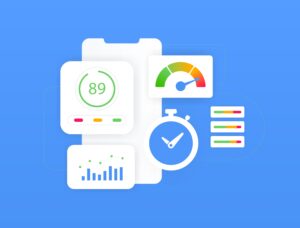
A beginner’s guide to analysing website data

Any business owner with a website knows the power of having an online presence—a digital storefront for customers to get a better understanding of you and your business in seconds.
But do you sometimes wish you could get a better understanding of the type of people looking at your website? And what types of things do they do once they reach your website? This is what analysing website data is all about.
With the correct approach, diving into your website data can unlock valuable insights into user behaviour. In-depth analysis should leave you with actionable strategies that can transform your marketing efforts, elevate your brand and enhance business performance.
Let’s get started with the basics…
What is website data and why is it important?

Website data is an umbrella term for all of the information collected about the engagement, demographics and activity of users who visit your website. Website data can also cover things such as your website speed, technical SEO, ranking information, conversion rates etc.
Analysis is the process of turning this raw data, into actionable insights that will have a positive impact on your overall website and business performance. Analysing your website data should give you the confidence to make data-driven decisions for your business.
- SEO analysis- Assessing a website’s visibility and checking best practices are followed for on-page, off-page, local and technical SEO.
- Performance analysis- Checking page speed, loading times and responsiveness is all performing well
- Conversion rate optimisation analysis (CRO)– Using heatmap tools, traffic data and design aspects to find conversion paths and issues
- Usability analysis- Assessing whether the site is accessible and easy to use
- Content analysis- Looking to see if the content on the site matches user intent, is informative and SEO optimised.
Analysing your website data will allow you to:
- Identify opportunities where you could improve your site conversion rate
- Fix technical issues on your site like slow loading times or incorrect redirects, which could be harming user experience.
- Discover opportunities to improve content and rank higher for your chosen keywords
Get to know the tools

Before we go through the steps, you need to make sure you are at least familiar with the data tools and what the metrics mean. Below is a list of some free, beginner-friendly platforms, but you may want to do some extra reading before you dive in.
You may already be familiar with some of the Google tools, Search Console and your Google Ads account if you run paid campaigns. For a more comprehensive look at your website data, Google Analytics 4 (GA4) can provide several key metrics across both organic and paid avenues.
Key metrics that GA4 provides include:
| Total website traffic | The number of people visiting your website |
| Page views | How many views each page has including repeat visits |
| Engagement time | Average time users spend engaging with pages on the site/whole site |
| The source of traffic | Where your audience has come to your website from (PPC ad, social media, email etc) |
| User location | Where the user is located when they accessed your site |
| Conversion rates/ conversion paths | Percent of users who converted after visiting your site |
| Engagement rate | The percentage of users who view more than one page or complete one action before exiting |
| Bounce rates | Users who leave the site without engagement |
The performance of your website isn’t just determined by GA4. You also need to consider the technical elements of your website, or how well your content is performing against competitors.
Other tools to help you gather website data include:
Screaming frog– An all-in-one technical SEO tool for metrics on your site giving insight into structure, duplicate content, redirects, broken links and missing page titles
Ahrefs– A key tool for keyword ranking tracking, backlink profiles and site audits. This tool is great for competitor analysis.
Page speed insights– Google’s own tool for checking your website speed and loading times. You will receive a score out of 100, and suggestions on where you could improve your website speed.
Figpii– A CRO tool which can provide heatmaps, and session recordings and help with surveys to see where users might be getting frustrated with usability, and bouncing off the site.
5 steps to analysing website data
Now that you can see the importance of analysing your website data and the tools to do so, you need to have a plan of how you’re going to sift through and make sense of it all.
1. Identify what you want to gain from analysing your website data
After you become familiar with the tools, you might find there is a particular part of your website you want to improve- content maybe? Or have you noticed an unusual drop in traffic that you can’t explain? A quick scan of the metrics should help you to identify areas you would like to look into further, and hopefully identify some actionable insights.
If you keep the goals of the analysis, you are more likely to find and identify opportunities. You could always note down a few areas of focus and carry out multiple analyses across a few weeks.
2. Pinpoint goals and objectives
Knowing the end goal can make choosing the starting point a whole lot easier. Being too broad with your goals, or not having one at all, can make it hard to identify specific opportunities.
Also having too many goals can make you lose track in the process. Keep note of what you want to analyse, pick one, and save the rest for future analysis.
Help keep your goals realistic and achievable by following the SMART goals method which we use here at Embryo.
3. Look at the specific data
For your chosen goal/objectives make specific note of the metrics that align with this. For example, if you want to improve conversions, you may look at bounce rates, engagement rates and conversion paths.
If you want to improve website speed, you could use tools which look at if you have large image file sizes, unoptimised code or several overlapping plugins.
To increase traffic, you should be looking at keyword data, your page titles and meta descriptions.
4. Make the changes
Your data collection should give you insights into what user behaviour is like on your site. Imagine the user journey and the interaction they have with your pages to identify where the improvements could be made. For example, if you have high traffic, but a low conversion rate, there might be a problem with the design/position of your CTAs. Your forms could be too long or detailed, causing users to become frustrated and bounce off the site.
When making website changes, start small so that you can identify what is working and where the improvements had an effect.
5. Track changes and repeat
Analysing your website data isn’t a one-off process. By carrying out these steps you can make sure that the changes you have made are having a positive effect. This is important for both new pages, old pages, and the high-traffic home pages on your site.
Go that step further with competitor website data analysis
Getting to grips with your own website data analysis can take a while. But once you’ve got this mastered and you feel confident with the tools, why not have a look at what your competitors are doing?
A competitor website analysis can help you see the online experience that users are getting elsewhere, and inspire your own strategy.
Dont just stop at direct competitors who sell/provide the same products and services as you. Have a look at sites that are ranking against your key pages and see what you could be missing on your pages.
A competitor analysis is a whole other topic- for more detail see our blog on how to carry out a PPC competitor analysis.
Your website data is sensitive

Yes, looking at competitor data can be extremely useful, but there is a limit to what you can access of other’s data, and what others can access about you.
Your internal data, and the data you collect about your website users/ customers is extremely sensitive. Under the 2018 GDPR law, holding this data comes with a certain level of responsibility.
As we now know, website data is extremely valuable to you and your business. However, this type of data can also be valuable (and can be used unethically) if in the wrong hands.
Here are a handful of reasons why people outside your business may want your website data:
- Competitors who may benefit from having your website data. They could want customer demographic data to help inform their advertising.
- Disgruntled employees who want to harm the business or may benefit from handling sensitive data.
- Hackers know the value of sensitive data like this and could either resell it to a third party or use it as a way to blackmail your company for financial gain.
This is why it’s more important than ever to ensure, as a business owner, that you have the correct security measures set up on your website.
This could include:
- Anti-virus software update on all electronic devices used by the business
- Setting up a VPN (Virtual Private Network)
- Using a password storage system for company-wide tools and platforms.
- Attend training courses and educate staff on the importance of strong passwords, data sharing and phishing scams.
- Setting up two-factor authentication for internal platforms.
Want expert advice on how to start using your website data?
Here at Embryo, we know the power of data. How to correctly analyse, and put it to the test, is what can take your website to the next level.



